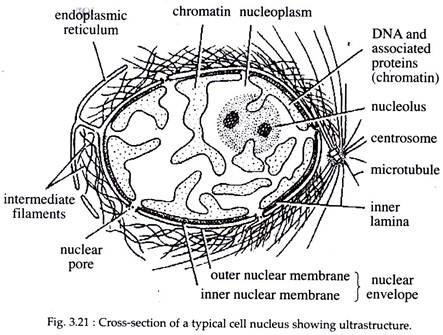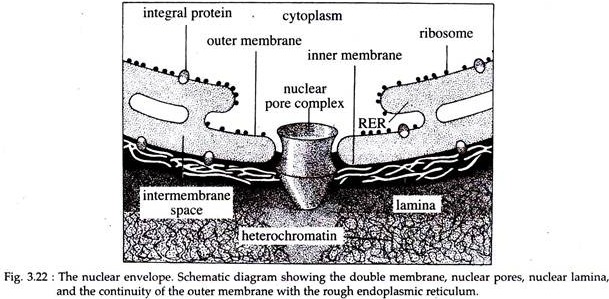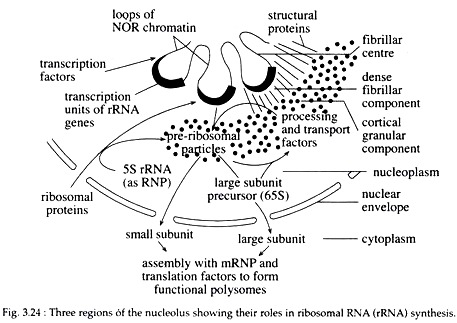In this article we will discuss about:- 1. Meaning of Nucleus 2. Structure of Nucleus.
Meaning of Nucleus:
Robert Brown for the first time in 1833 discovered a prominent body within the cell and termed it nucleus. Later on, in 1934 the German biologist J. Hammerling, demonstrated that the nucleus determines the characters of a cell and ultimately the characters of an individual.
The nucleus is found in all eukaryotic cells of plants and animals. However, certain eukaryotic cells such as mature serve tubes of higher plants and mammalian erythrocytes contain no nucleus.
On the basis of presence or absence of well-defined nucleus, cells are classified into two groups:
ADVERTISEMENTS:
(i) Prokaryotic cells with no organised nuclei (without nuclear membrane) and
(ii) Eukaryotic cells having organised nuclei with nuclear envelopes.
The prokaryotes include bacteria and blue green algae, while eukaryotes include all higher organisms. The nuclear equivalent of a prokaryotic organism is known as prokaryon or more commonly as nucleoid, rather than a nucleus.
The nucleoid does not have true chromosome; it is not enclosed in a nuclear envelope and does not divide by regular mitosis. On the other hand the nucleus of an eukaryotic cell remains enclosed by a complex nuclear envelope.
ADVERTISEMENTS:
Within the envelope of an interphase (non-mitotic) nucleus, there are:
(i) Chromosomes,
(ii) Nuclear matrix,
(iii) One or more nucleolus and
ADVERTISEMENTS:
(iv) Nucleoplasm.
Usually one cell contains one nucleus but the number may vary from cell to cell. Paramoecium and cells of liver and cartilage contain two nuclei and in plants, certain fungi and some protozoans are best example of poly-nucleated cells. The size of the nucleus of a cell depends on the volume of the cell, amount of DNA and proteins, and metabolic phase of the cell.
Structure of Nucleus:
Under light microscope, nucleus is visualized as a viscous mass surrounded by a distinct envelope. One or several nucleoli can also be observed inside the nucleus. However, under electron microscope (EM) a typical eukaryotic interphase (non-mitotic) nucleus appears to have some other components.
Ultrastructure:
The nucleus under EM, appears to be composed of:
(i) Nuclear membrane or nuclear envelope,
(ii) Chromatin fibre (chromosomes),
(iii) Nuclear matrix,
(iv) Nucleolus and
ADVERTISEMENTS:
(v) Nucleoplasm or nuclear sap (Fig. 3.21).
Nuclear Envelope:
The nuclear envelope is a special perinuclear cisterna of the cell endomembrane system at the boundary between the nucleus and the surrounding cytoplasm of an eukaryotic cell. It consists of two concentric membranes separated by a perinuclear space of 10 to 15 nm.
The two membranes are fused at sites forming a circular pore that contains a complex assembly of proteins. The average mammalian cell contains approximately 3,000 nuclear pores. The outer membrane is generally studded with ribosomes and is often seen to be continuous with the membrane of endoplasmic reticulum (Fig. 3.22).
The inner surface of the nuclear envelope is lined by a dense fibrillar meshwork, called the nuclear lamina (Fig. 3.22). The fibrils of the nuclear lamina are approximately 10 nm in diameter and composed of polypeptides, called lamins.
The lamina is thought to act as a structural support for the nuclear envelope and to serve as a site of attachment for the chromatin fibres at the nuclear periphery. The disassembly of the nuclear lamina prior to mitosis is thought to be induced by phosphorylation of the lamins by a specific kinase enzyme.
Nuclear Pore Complex:
Nuclear pores contain a complex, basket like apparatus, called the nuclear pore complex (NPC) that fills the pore like a stopper, projecting outward into both the cytoplasm and nucleoplasm. The NPC is a huge molecular complex that exhibits octagonal symmetry and contains an estimated 100 to 200 polypeptides. The mass of an NPC is approximately 30 times that of a ribosome.
Electron micrographs of NPC revealed that it has four separate elements:
(i) The scaffold is a stack of three closely apposed rings; the cytoplasmic ring, the nucleoplasmic ring and a central ring of thick spokes,
(ii) The central hub or transporter is a proteinaceous ring and consists of two irises of eight arms each,
(iii) Short thick filaments attached to the cytoplasmic side of the pore and
(iv) A basket attached to the nucleoplasmic side of the pore (Fig. 3.23). Nuclear pore complexes are the sites of exchange of macro molecules like proteins, RNAs etc. between the cytoplasm and the nucleus. Each single pore is capable of bi-directional transport (import or export) Which is facilitated by the presence of signal sequences.
Chromosomes (Chromatin fibre):
In all types of higher organisms, the well organised nucleus contains definite number of chromosomes of definite size and shape. The chromosomes are invisible in the interphase nucleus but seem to appear out of nowhere at the beginning of mitosis and disappear once again following mitosis.
It has long been known that chromosomes consist of fibres, called chromatin, that are composed of DNA and associated proteins. The structure and function of chromatin fibre (chromosomes) have been discussed separately elsewhere.
Nuclear Matrix:
If lipids, histone, non-histone proteins and DNA fibres are removed from the nucleus, the structure that remains possesses the same shape as the original nucleus but is composed of a net-work of thin protein, containing fibrils crisscrossing through the nuclear space. This insoluble fibril or network is called nuclear matrix.
It serves as more than a skeleton to maintain the shape of the nucleus or a scaffold on which loops of chromatin are organised. It also serves to anchor much of the machinery that is involved in the various activities of the nuclei, including transcription, RNA processing and replication.
Nucleolus:
Every eukaryotic cell contains one or more spherical, colloidal acidophilic bodies, called nucleoli (Fig. 3.21). A nucleolus is often associated with a particular region of nucleolar organising chromosome that is called nucleolar organizer (NO) representing the secondary constriction.
Nucleolus is not bounded by any limiting membrane. Chemically it contains DNA of nucleolar organizer, four types of rRNAs, 70 types of ribosomal proteins, RNA binding proteins (e.g., nucleolin) and RNA splicing nucleoprotein. It also contains phospholipids, enzymes (e.g., acid phosphatase, nucleoside phosphorylase) and Ca++ ions.
Nucleolus is the site of ribosome biosynthesis, where the synthesis of ribosomal RNA (rRNA) and the assembly of ribosome take place. Within the nucleolus there are three distinct regions in relation to the ribosome formation.
These are:
(i) Fibrillar centre (FC), where rRNA genes of NO are located; the transcription of rRNA genes also takes place in this region,
(ii) Dense fibrillar component (DFC), which surrounds the fibrillar centre and where RNA synthesis progresses. The 80 S ribosomal proteins (rps) also bind to the transcripts in this region,
(iii) Cortical granular component (GC) is the outermost region having granules of 15 to 20 nm.
Here processing and maturation of pre-ribosomal particles occur (Fig. 3.24). The transcription for the synthesis of pre-RNA actually occurs in FC and particularly at its edge in a region described as transcription zone (txn). Like Sn RNAs (small nuclear RNAs) more than 50 types of small nucleolar RNAs are found in nucleolus. Some of these are involved in processing of pre-rRNA.
Nucleolus disappears during mitosis and reappears at the next interphase. It is suggested that pre-nucleolar bodies are the precursors of newly formed nucleoli but the actual mechanism of nucleogenesis is still unknown.
Nucleoplasm:
The nucleolar components such-as the chromatin threads and the nucleolus remain suspended in a transparent, semi-solid, granular and slightly acidophilic ground substances, called nucleoplasm or nuclear sap or karyolymph.
It is composed of mainly the nucleoproteins but also contains other inorganic and organic substances, viz., nucleic acids, proteins, enzymes and minerals. The most common nucleic acids of the nucleoplasm are the DNA and RNA.
Proteins present in nucleoplasm are of two types:
(i) Basic proteins or histones that are rich in arginine, lysine and histidine,
(ii) Non histones or acidic proteins that include different phosphoproteins. Most important nuclear enzymes are DNA polymerase, RNA polymerase, NAD synthetase, nucleoside triphosphatase, nucleoside phosphorylase, aldolase, enolase, pyruvate kinase etc. The nucleoplasm contains several inorganic compounds like phosphorus, potassium, sodium, calcium and magnesium.



